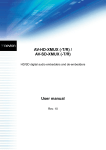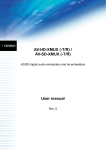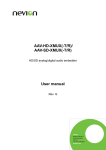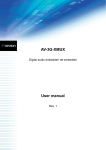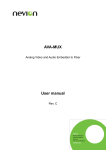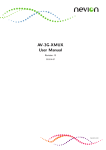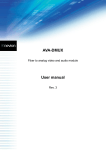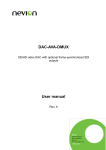Download AV-HD-XMUX (-T/R)
Transcript
AV-HD-XMUX (-T/R) / AV-SD-XMUX (-T/R) HD/SD digital audio embedders and de-embedders User manual Rev. L Nevion Nordre Kullerød 1 3241 Sandefjord Norway Tel: +47 33 48 99 99 nevion.com AV-HD-XMUX (-T/R) / AV-SD-XMUX (-T/R) Rev. L Nevion Support Nevion Europe Nevion USA P.O. Box 1020 3204 Sandefjord, Norway Support phone 1: +47 33 48 99 97 Support phone 2: +47 90 60 99 99 1600 Emerson Avenue Oxnard, CA 93033, USA Toll free North America: (866) 515-0811 Outside North America: +1 (805) 247-8560 E-mail: [email protected] See http://www.nevion.com/support/ for service hours for customer support globally. Revision history Current revision of this document is the uppermost in the table below. Rev. L 10 Repl. 11 9 Date 2015-05-27 2011-11-22 Sign MB AJM, MDH 9 8 2009-03-30 NBS 8 7 6 5 4 7 6 5 4 3 2008-03-28 2008-02-15 2008-02-13 2007-10-30 2007-10-30 NBS MDH NBS NBS NBS 3 2 2007-04-10 MDH 2 1 2006-09-08 MDH 1 0 0 - 2006-02-14 2006-02-01 MDH MDH Change description Template update; DoC removed Updated optical specifications. Added references to audio transport mode. Removed references to the AV-HD-XMUX-C3 Corrected minimum optical input specification. New front page. Changed GPI connector figure. Inserted AV-HD-XMUX-C3 backplane. Corrected description of AV-HD-XMUX-C2. Corrected Chapter 2.4.2 (PIN diode description). Changed matrix in Chapter 3.1.2 and added description of Dip positions in Chapter 3.1.3. Generator controls in firmware vn.5. Audio delay line section. References to AV-SD-XMUX. Group router switching, video input switching, latency specifications, new generator functionality. Introduction bullets. Routing DIP switch table. Revised specifications. nevion.com | 2 AV-HD-XMUX (-T/R) / AV-SD-XMUX (-T/R) Rev. L Contents 1 Product overview ..................................................................................................... 5 1.1 Audio signal flow ............................................................................................................. 6 1.2 Signal flow ....................................................................................................................... 7 1.3 Data signal ...................................................................................................................... 7 1.4 Video reference ............................................................................................................... 7 2 Specifications .......................................................................................................... 8 2.1 Measurement conditions.................................................................................................. 8 2.2 General ........................................................................................................................... 8 2.3 Processing....................................................................................................................... 8 2.3.1 SD latencies ................................................................................................................. 8 2.3.2 HD latencies ................................................................................................................. 8 2.4 Inputs .............................................................................................................................. 9 2.4.1 Electrical video input ..................................................................................................... 9 2.4.2 Optical video input ........................................................................................................ 9 2.4.3 Audio Inputs ................................................................................................................. 9 2.4.4 Data inputs ..................................................................................................................10 2.5 Outputs...........................................................................................................................10 2.5.1 Electrical video output..................................................................................................10 2.5.2 Optical video output .....................................................................................................10 2.5.3 Audio outputs ..............................................................................................................10 2.5.4 Data outputs ................................................................................................................11 2.5.5 GPI outputs .................................................................................................................11 3 Configuration ......................................................................................................... 12 3.1 DIP switch routing...........................................................................................................12 3.1.1 Destinations.................................................................................................................12 3.1.2 Sources .......................................................................................................................13 3.1.3 Examples.....................................................................................................................13 3.2 Other DIP Switches ........................................................................................................14 3.2.1 Non-SRC mode, SW1.7...............................................................................................14 3.2.2 Load DIP Configuration, SW1.8 ...................................................................................14 3.2.3 LED mode, SW2.7 .......................................................................................................15 3.2.4 EDH insert, SW2.8 ......................................................................................................15 3.2.5 Fallback generator control, SW3.7 ...............................................................................15 3.2.6 20/24 bit (SD), SW3.8 ..................................................................................................15 3.3 GYDA Control.................................................................................................................15 3.3.1 Audio delay lines .........................................................................................................15 3.3.2 Stereo audio processing ..............................................................................................15 3.3.3 RS422 Data port configuration.....................................................................................16 3.3.4 Transport and shuffling of audio groups .......................................................................16 3.3.5 Audio generator ...........................................................................................................16 3.3.6 Video generator ...........................................................................................................16 3.3.7 Video input switching ...................................................................................................16 3.4 Data transmission ...........................................................................................................17 3.4.1 Data latencies ..............................................................................................................17 3.4.2 Embedding ..................................................................................................................17 3.4.3 De-embedding .............................................................................................................17 3.4.4 Limitations ...................................................................................................................18 3.5 Audio Transport mode ....................................................................................................18 3.5.1 In-band management...................................................................................................18 3.5.2 Setup ...........................................................................................................................18 nevion.com | 3 AV-HD-XMUX (-T/R) / AV-SD-XMUX (-T/R) Rev. L 4 Connections........................................................................................................... 20 4.1 Summary ........................................................................................................................22 4.2 Audio connections DB25 ................................................................................................22 5 Operation ............................................................................................................... 23 5.1 Front panel LEDs............................................................................................................23 5.2 GPI alarms .....................................................................................................................24 5.2.1 GPI/ Data connections RJ45........................................................................................24 6 Laser safety precautions........................................................................................ 25 General environmental requirements for Nevion equipment..................................... 26 Product Warranty ...................................................................................................... 27 Appendix A Materials declaration and recycling information..................................... 28 nevion.com | 4 AV-HD-XMUX (-T/R) / AV-SD-XMUX (-T/R) Rev. L 1 Product overview The only difference between the AV-SD-XMUX and the AV-HD-XMUX is that the latter can also handle HD SDI video. The rest of the manual will only refer to the AV-HD-XMUX. The AV-HD-XMUX is a highly integrated audio embedding module in the Flashlink range, offering simultaneous embedding and de-embedding of four AES3 stereo digital audio channels from a digital HD or SD serial video signal. The modules can: AV-HD-XMUX can handle SD and HD digital uncompressed video. AV-SD-XMUX can handle SD digital uncompressed video. De-embed and embed all groups of audio. Copy or move audio groups without additional delay. De-embed 4 AES3 digital audio and non-audio signals. Embed 4 AES3 digital audio and non-audio signals. Apply sample rate converters when needed. Apply extra audio delay. Swap stereo channels. Make mono or sum from stereo signals. Have optical laser output. Have optical input. Transport asynchronous serial data. Generate video and audio signals. De-glitch correctly synchronized switched video. The module has two main processing blocks. One processes the video stream and the packet data, the other processes the audio. The packet processing core forms a group router which can route embedded audio between groups without any extra delay. The AV-HD-XMUX audio core is an AES3 audio router. The received embedded audio and the AES3 inputs are the sources in the router. The embedded output groups and AES3 outputs are the destinations. This feature may also be used to perform stereo channel swapping. Four stereo delay lines are also available in the router with a total combined delay of 1.25s. Audio processing is possible within each stereo output. The channels may be changed allowing L/R swapping, mono assignment, summing, MS conversion and phase reversal of one of the signals. There are two embedding modes. Non-SRC mode: The AES3 input signals are embedded transparently. Automatic mode: The module will use sample rate converters when necessary. Data signals such as Dolby E will always be embedded transparently without using the sample rate converters. All embedding and de-embedding is performed with synchronous 48 kHz audio. nevion.com | 5 AV-HD-XMUX (-T/R) / AV-SD-XMUX (-T/R) Rev. L The unit may be ordered with optional optical transmitters and receivers. The laser options range from the standard -7.5dBm 1310nm to the CWDM units. The receivers may be either HD, which will receive both HD and SD data rates; or SD which has a multimode fiber. The module has signal generators for audio and video for test and line up applications. The internal video generator may be used as a fall-back source that is used if the both the electrical and the optical input signals fail. This allows uninterrupted transmission of embedded audio. Figure 1: Module overview De-embedded groups 1 2 3 4 Delay 1-4 Group matrix 1 2 3 4 Stereo Matrix Embedded groups 1234 Silence AES inputs Stereo tone 1.1 Audio signal flow 1 2 AES 3 outputs 4 Figure 2: Processing core overview nevion.com | 6 AV-HD-XMUX (-T/R) / AV-SD-XMUX (-T/R) Rev. L 1.2 Signal flow Video may be presented on the optical or electrical inputs. The module will switch to the other input if the module can not lock to a signal. The video is re-clocked and transformed to parallel video. The parallel video goes into a line buffer which is used to de-glitch the video when switched on the correct line. No errors are flagged or produced when the video is switched on the appropriate switching line. All ancillary data, including embedded audio is extracted from the video signal. All the packed data is sent to the group router. The deembedded audio is sent to the stereo audio cross-point router. The AES audio inputs are initially connected directly to the audio router. Sample rate converters are inserted if there are sample slips and the signal is not a data signal. The sample rate converters may be disabled with DIP switch 1.7. The audio processing is performed on the stereo router outputs. Four of the router outputs are connected to the four stereo delay lines. The outputs of the delay lines are connected to four inputs of the stereo audio router. The audio signal is delayed by a few samples during de-embedding, re-packeting the audio and audio processing. Signals that pass through the stereo audio router will be delayed by a small number of samples. The group router outputs from the de-embedders do not introduce any additional delay as the audio does not require unpacking and re-packing. The embedder core embeds either re-packeted audio from the stereo router or the existing de-embedded audio as configured in the group router. The embedded audio packets are inserted into the video signal together with the control packets and any other packets that were present in the original video signal. The video is serialized and output through the cable and laser drivers. The AES audio signals are taken from the outputs of the audio router. 1.3 Data signal The data signal is transported using the User bits in one of the embedded audio streams. De- embedded data is output on the RS485 output and data received at the R422 input is embedded into the output video. The configuration sets the audio source containing the data signal to de-embed, the data format to be received on the backplane connector and which output signal to embed data into. 1.4 Video reference The input video always has the highest priority. The output video and audio will always be synchronous to this signal. AES input 1 will be used as a reference for the internal video generator as long as the sample rate converter is not active. ( FPGA firmware 1.56 and greater. Contact Support for upgrade) The internal generator will run at a frequency close to the last valid signal. nevion.com | 7 AV-HD-XMUX (-T/R) / AV-SD-XMUX (-T/R) Rev. L 2 Specifications 2.1 Measurement conditions Audio Sampling rate Ambient temperature 48 kHz 25ºC 2.2 General Power: Control: Monitoring: EDH/CRC processing: Boot time: Audio inputs and outputs: Video inputs and outputs: Data input and output: +5V DC 0.66A 3.3W DIP switches, GYDA system controller. Front panel LEDs, GYDA system controller and GPI. Full. Received flags are updated, new CRCs are calculated. 1 second Conform to AES3-2003 Conform to SMPTE 292M-1998 Conform to EIA RS-485 2.3 Processing Video latency is variable due to the de-glitcher but the values below apply when the video signal is first applied. Other latency values are maximum values. 2.3.1 SD latencies Video: Audio embedding: Audio de-embedding: Embedding GPI mode: Embedding UART mode: De-embedding GPI mode: De-embedding UART mode: des+4+350+256+2+ser video samples = 45.3us AES+2+1+16 audio samples=20/48000 = 417us 4+16+1 audio samples =21/48000 = 438us 8+4+32 96kHz samples =44/96000 = 458us 32+128+17+16 96kHz samples =193/96000 = 2.01ms 8+32+8 96kHz samples =44/96000 = 458us 8+32+8 96kHz samples =48/96000 = 458us 2.3.2 HD latencies Video: Audio embedding: Audio de-embedding: Embedding GPI mode: Embedding UART mode: De-embedding GPI mode: De-embedding UART mode: des+8+1024+1024+3+ser video samples = 27.6us AES+2+1+8=12 /48000 = 250us 2+8+1=11/48000 = 229us 8+4+16 96kHz samples =28/96000 = 292us 16+128+17+16 96kHz samples =177/96000 = 1.84ms 4+16+8 96kHz samples =28/96000 = 292us 4+16+8 96kHz samples =28/96000 = 292us nevion.com | 8 AV-HD-XMUX (-T/R) / AV-SD-XMUX (-T/R) Rev. L 2.4 Inputs 2.4.1 Electrical video input AV-HD-XMUX Video Data rate: Video frame rate: AV-SD-XMUX 270Mbps or 1,485Gbps 24p, 50i, 60i, 50p or 60p and pull down rates Video Data rate: Video frame rate: Equalization: Impedance: Return loss: Signal level: Connector: 270Mbps 50i and pull down 60i rates Automatic up to 35dB 75 ohm >15dB up to 1,5GHz nom. 800mV BNC 2.4.2 Optical video input Optical wavelength: Maximum Optical power: Minimum Optical power HD-SDI SD-SDI Return loss: Maximum reflected power: Transmission circuit fiber: Connector: 1200-1620nm ±40 nm -3 dBm. -22 dBm -25 dBm Better than 27 dB. 4% Single mode (Multi-mode option on request). SC/UPC 2.4.3 Audio Inputs Number of AES3 inputs: Audio data rate: Impedance (C1 backplanes): Connector (C1 backplanes): Impedance (C2 backplanes): Connector (AV-HD-XMUX-C2): Connector (AV-MUX-C2): Embedded audio word length: Embedded audio Channel status: Sample rate converter dynamic range: 4 30 kHz to 200 kHz, converted to 48 kHz if not isochronous to the video input signal. 110 ohm transformer balanced. 25 pin D-sub. (4 Inputs + 4 outputs) 75 ohm unbalanced. 2 x BNC 4 x BNC 24 bits As received when isochronous, otherwise fixed. 139 dB(A) @ 1 kHz nevion.com | 9 AV-HD-XMUX (-T/R) / AV-SD-XMUX (-T/R) Rev. L 2.4.4 Data inputs RS422 Connector Packet mode: Baud rates Data length Parity Stop bits GPI mode: Raw data sampling frequency: 1 RJ45 9600 to 115200 7 or 8 bits None, odd or even 1, 1.5 or 2 bits 93750 Hz 2.5 Outputs 2.5.1 Electrical video output Number of HD/SDI outputs: (AV-HD-XMUX-C3) Connector: Impedance: Return loss: Signal level: Rise/fall time: 1 2 BNC 75 ohm > 15 dB to1.5GHz nom. 800mV. typically 650ps. @270Mbps. < 270ps @1.485Gbps 2.5.2 Optical video output Optical wavelength (13T): Light source: Optical power: Extinction ratio: Optical wavelengths (13T0, 15T, CxxxxT): Light source: Optical power: Extinction ratio: Jitter (UI=unit interval): Return loss: Maximum reflected power: Transmission circuit fiber: Connector: 1310nm ±40nm FP semiconductor laser -7.5 dBm >5:1 1270, 1290, 1310, 1330, 1350, 1370, 1390, 1410, 1470, 1490, 1510, 1530, 1550, 1570, 1590, 1610nm ±6nm DFB semiconductor laser 0 dBm >10:1 <0.135 UI @ SD, <0.2 UI @ HD better than 40 dB typ. 4% 9/125um Single Mode SC/UPC 2.5.3 Audio outputs Number of AES3 outputs: Audio data rate: Impedance (C1 backplanes): Connector (C1 backplanes): Impedance (C2 & C3 backplanes): Connector (AV-HD-XMUX-C2): Connector (AV-MUX-C2 & AVHD-XMUX-C3): 4 48 kHz 110 ohm transformer balanced. 25 pin D-sub. 75 ohm unbalanced. 2 x BNC 4 x BNC nevion.com | 10 AV-HD-XMUX (-T/R) / AV-SD-XMUX (-T/R) Rev. L 2.5.4 Data outputs Number of RS485 outputs Connector 1 RJ45 2.5.5 GPI outputs Signals: Connector: Signal type: Maximum voltage: Maximum current: Power status good, no video input lock, laser failure. RJ45 Open drain transistor with free-wheel diode. 100 V 150 mA nevion.com | 11 AV-HD-XMUX (-T/R) / AV-SD-XMUX (-T/R) Rev. L 3 Configuration The XMUX embedding core can be considered as an 18x16 stereo audio router and a 5x4 group router. The group router is used to transport or shuffle groups without introducing any additional delay. The inputs or sources in the stereo router are from the de-embedded audio groups, the AES inputs, the delay line outputs and the two built in generators. The stereo router outputs or destinations are the groups of embedded audio in the output video, the AES outputs and the delay line inputs. A normal de-embedder configuration would route the de-embedded audio to the AES outputs. A normal embedder configuration would be to route the AES inputs to the appropriate embedder group outputs. The AV-HD-XMUX module can do both at the same time! Many other configurations are possible and the module may be dynamically controlled as an 18x16 audio router via the system controller, GYDA. Full control of the module is performed with the GYDA system controller. Controls only possible with GYDA are: The data transmission parameters and channel selection. The output processing of each stereo signal (LR, RL, LL, RR, MS, Sum, ØLR, LØR). The delay lines delays and routing. Video and audio generator configuration. 3.1 DIP switch routing Full hardware control of all of the parameters in the module would require either, a complicated menu type of control interface with a display and control buttons; or an enormous number of switches. In many cases, most of the parameters will not be changed from the default settings. It was decided to control only the most used parameters with switches. This still requires the use of 24 switches. The switches are only read during the power-up process, if SW1.8 (Load DIP config) is in the on position (see 3.2.2) and if there is no GYDA connected. There are not enough switches on the module to allow full stereo routing configurations. Groups of four channels are routed together as units, for example: AES input channels 1&2, embedded audio group 1. 3.1.1 Destinations Group1 1 2 3 SW1 Group2 4 5 6 * 7 * 8 Group3 1 2 3 SW2 Group4 4 5 6 * 7 * 8 AES1&2 1 2 3 SW3 AES3&4 4 5 6 * 7 * 8 Table 1: Routing control switches The switches control the routing of signals to the outputs or destinations. There are four embedded audio groups and two sets of AES outputs, AES outputs 1&2 and AES outputs 3&4. nevion.com | 12 AV-HD-XMUX (-T/R) / AV-SD-XMUX (-T/R) Rev. L The configuration assigns sources to output groups and AES output pairs. This allows the same input signals to be routed to several outputs. There is a group of three switches for each of the outputs. The combination of the three switches set the input source or disables the output e.g. Group 1 embedded output is controlled by switches on SW1 positions 1, 2 and 3. AES outputs 3&4 are controlled by switches on SW3 positions 4, 5 and 6. 3.1.2 Sources There are eight possible permutations of the switches. Seven of the permutations choose the input sources. One of the settings (off, off, off) is used to disable the group embedding or set the AES outputs to silence. Switch # 1 or 4 2 or 5 3 or 6 Output disabled Off Off Off Group 1 Off Off On Group 2 Off On Off Group 3 Off On On Group 4 On Off Off AES 1 & 2 On Off On AES 3 & 4 On On Off Stereo tone On On On Table 2: Source switch encoding 3.1.3 Examples Figure 3: Example 1 The module above (Figure 3) is set to the following: Group1 output is embedded with signals from AES1&2 inputs (On,Off,On). Group2 output is embedded with signals from AES3&4 inputs (On,On,Off). Group3 output is embedded with signals from de-embedded group3 (Off,On,On). Group4 output is not embedded (Off,Off,Off). AES1&2 outputs signals from de-embedded group1 (Off,Off,On). nevion.com | 13 AV-HD-XMUX (-T/R) / AV-SD-XMUX (-T/R) Rev. L AES3&4 outputs signals from de-embedded group2 (Off,On,Off). Figure 4: Example 2 The module above (Figure 4) is set to the following: Group1 output is embedded with signals from de-embedded group1 (Off,Off,On). Group2 output is embedded with signals from AES1&2 inputs (On,Off,On). Group3 output is embedded with signals from AES3&4 inputs (On,On,Off). Group4 output is not embedded (Off,Off,Off). AES1&2 outputs signals from de-embedded group1 (Off,Off,On). AES3&4 outputs signals from de-embedded group1 (Off,Off,On). Users familiar with binary numbers may see that numbers 1 to 4 (001 to 100) correspond to groups 1 to 4. 5 and 6 (101 and 110) correspond to the first and second AES pairs. 3.2 Other DIP Switches 3.2.1 Non-SRC mode, SW1.7 When SW1.7 and SW1.8 are on, the sample rate converters will not be used. The user must ensure that the AES input signals are locked to the video signal audio, otherwise click noises will be produced in the embedded audio signals. 3.2.2 Load DIP Configuration, SW1.8 SW1.8 on, forces the DIP switch configuration to be used. If there is a GYDA present, the switch configuration on the module will also overwrite the configuration stored in the GYDA controller. SW1.8 off will not use the DIP switches but will be configured from either the stored configuration in the module or from GYDA if there is GYDA present. The configuration will be stored when a GYDA configuration command is used. Therefore if a GYDA is present, the internal configuration will be overwritten by the GYDA controller. The switch settings are only read when the module is powered up. The DIP switch settings control the routing and a couple of other important settings. Other stored settings, such as data embedding and generator settings will always be used. nevion.com | 14 AV-HD-XMUX (-T/R) / AV-SD-XMUX (-T/R) Rev. L 3.2.3 LED mode, SW2.7 The switch controls how the two audio LEDs function. If the switch is off, the LEDs show the AES receiver status. If the switch is on, the LEDs show the presence of embedded groups. 3.2.4 EDH insert, SW2.8 SD video output from the module will only contain an EDH packet if SW2.8 is on. 3.2.5 Fallback generator control, SW3.7 This switch is used to control the outputs when the input signals are not present. SW3.7 on: The Video output will be disabled if the input signal is removed. Exception: The module will produce a video signal if the internal video generator is switched on to override the input. The AES outputs will be disabled if the source routed to that output is not present. The input presence is embedded in the embedded audio data packet so that an AES input failure will disable an AES output which uses that embedded audio. SW3.7 off: The internal video generator will be used as an input until a valid video signal is detected on one of the inputs. The AES outputs will always be on but the signal will be silence. 3.2.6 20/24 bit (SD), SW3.8 SD video will contain embedded audio with a word length of 24 bits if SW3.8 is on. SD video will contain embedded audio with a word length of 20 bits if SW3.8 is off. HD video will always contain embedded audio with a word length of 24 bits. 3.3 GYDA Control Full control of the stereo audio router is possible with the GYDA system controller. Direct control with SNMP is being developed. The module stores its routing configuration in non-volatile memory when a GYDA command is given. This allows complex configurations to be restored after a power loss. If a GYDA system controller is present, the last configuration of the module will be only be restored by GYDA if SW1.8 is off. The intention is that SW1.8 is used to show that the card is manually configured when switched on. 3.3.1 Audio delay lines The unit has four stereo audio delay lines connected to the audio router. Audio to be delayed is routed to one of the delay inputs and the output of that delay is routed to the intended output. The length of each delay line is set up on the configuration page of GYDA. The maximum delay for each of the four delays is 16384 audio samples, which is about 341ms. The delay lines may be cascaded if longer delays are required. 3.3.2 Stereo audio processing The output of each stereo signal may be manipulated (LL, RR, LR, RL ØLR, LØR, L+R/2, MS) this is controlled with the GYDA controller. The stereo signals may be output in one of the following ways: LR, Left / Right RL, Right/ Left LL, Left/ Left RR, Right/ Right No change. Channels are swapped. Left channel is copied into the right channel. Right channel is copied into the left channel. nevion.com | 15 AV-HD-XMUX (-T/R) / AV-SD-XMUX (-T/R) Rev. L ØLR, ØLeft/ Right LØR, Left/ ØRight L+R/2, Left + Right MS, MS/AB The left channel is phase inverted. The right channel is phase inverted. The left and right channels are summed. The left and right channels are converted from AB stereo to MS stereo. The sum products (L+R/2 and MS) are reduced in level by 6 dB to avoid any possibility of clipping. 3.3.3 RS422 Data port configuration The RS422 data RJ45 input must be configured with GYDA. The baud rate, data length, parity and stop bits must be configured if UART mode is used. The router destination where the data is to be embedded must be set up and the source channel containing the received data that will be output on the RJ45 must be also be configured. See section 3.4. 3.3.4 Transport and shuffling of audio groups The AV-HD-XMUX stereo audio router involves de-embedding, buffering and re-embedding which introduces a small delay relative to the video signal. The group router is used to avoid this extra delay. Groups that only pass through the group router are re-embedded in the same video line. This avoids any extra delay and means that incompatible audio formats (asynchronous audio) may still be transported. The AV-HDXMUX automatically uses transport mode whenever possible when controlled with the DIP switches. “Shuffling” of groups is when existing embedded audio groups are re-assigned to different groups. Copying of groups is also possible i.e. Group 1 may be transported to Group 1 and duplicated to Group 2. This function also takes place in the group router which means that there is no extra delay. 3.3.5 Audio generator The stereo audio generator is available in the audio router as a source. It is a high purity 1 kHz sine wave with a 250ms interruption on the left channel every 3 seconds. The audio level may be set to one of two standards. The two levels are -18 dBFS and -20 dBFS. These two levels correspond to EBU R68 and SMPTE RP 155. 3.3.6 Video generator The video generator has several different simple signals: Color bar, 100% white, 75% colors, no set-up level. Red, Green, Blue or Black full field. The generator may be used as the video source if there is no video signal present at either of the video inputs. The generator may also be switched on with GYDA. This will override video input but the generator signal will be locked to the input. The video standard of the generator may be set with GYDA but only if there is no video input present. 3.3.7 Video input switching The default mode of operation is auto-switch between the optical and electrical inputs. The video output may be configured to either use the internal generator, or to switch off when no video is detected on the inputs. The card will then use the internal generator while it switches between inputs until it finds a valid video signal. nevion.com | 16 AV-HD-XMUX (-T/R) / AV-SD-XMUX (-T/R) Rev. L The video generator may be selected to override the input video picture. The input video will decide the timing of the output video and any embedded packets will still be used by the module. Only the picture will be overwritten. This setting will only be restored when GYDA is present, as the generator picture may only be switched off again with GYDA. Upstream video switching in a router causes glitches in the digital video. The module will remove these glitches if the switch occurs on the correct video line for the standard in use. The input buffer is two video lines of the longest standard and starts in the middle. Subsequent switches will be transparent if the new signal is within a line from the original video. There will be a glitch on the output if the new video phase is outside of this range. The buffer will be re-aligned to the middle with the new signal phase. 3.4 Data transmission The module can de-embed and embed asynchronous data. An AES3 audio signal is used as a carrier. Both embedded audio and normal AES3 signals may be used to carry the RS422 data. The fiber connection usually only goes one direction so any desired return path must be created by the user with another circuit. Return data may be sent over fiber via a link comprising of AV-HD-XMUX, D422 or D422-MG modules. The RJ45 data input works in one of two modes: 1. UART Mode: The data is checked for correct reception according to the configuration. The data words are packaged and sent when present. 2. Raw sampling mode: The data input is sampled at 93.75 kHz and embedded as a data stream. No checking is performed. 3.4.1 Data latencies The data channel has a total latency of approximately 30µs when using raw sampling. Normal data rates of up to 9600 may be used with raw data sampling to have a low latency. The latency is 500µs when using the normal data encoding due to the block structure of the AES User bits. The configuration of the data channel is always stored in the module and used regardless of the GYDA override switch. 3.4.2 Embedding The AV-HD-XMUX has a RS422 data input for the embedding of control data. The baud rate and other parameters are configured with GYDA. The factory default is 115200 baud, no parity, and one stop bit. The data channel is encoded in the User bits in an embedded audio stereo signal assigned with GYDA. The factory default is Audio channels 1&2 in Group 1. The data is sampled asynchronously at a constant bit rate. The range of baud rates is from DC to 115,200 bps. The data bytes are either encoded as packets in the transmitted data or transmitted as an asynchronous bit stream which may also be used to transmit a DC signal such as GPI. 3.4.3 De-embedding The audio channel with the data signal to be de-embedded must be configured by GYDA as there may be several data channels available. The AV-HD-XMUX will automatically detect the data channel format when present and output the data on the RJ45 connector. The output driver will only be active when data is output in UART mode. The means that the output is always active when raw data is used. nevion.com | 17 AV-HD-XMUX (-T/R) / AV-SD-XMUX (-T/R) Rev. L 3.4.4 Limitations 1. There is one thing the user must do in order to receive embedded data. The audio source where the data is embedded must be routed to a destination in the stereo router. This is because the extraction of the data takes place on the output of the router. Example: Data is to be de-embedded from embedded audio channels 1&2. Embedded audio channels 1&2 routed to output to Delay 4. 2. The normal UART mode checks the data when receiving and only embeds valid bytes. The data format must be correct. This also means that a BREAK condition of many spaces will not be detected or transmitted. Contact support if this is a requirement. 3.5 Audio Transport mode This is a special DIP switch controlled mode to set up the module when used to transport audio from a ‘base frame’ to a ‘remote frame’ and back again. The audio is transported transparently on groups 1 and 2. This mode is especially useful to transport popular intercom signals between locations. 3.5.1 In-band management GYDA control data may also be transported to and from a remote frame with this mode. The physical connections between the backplane RS485 connector and the frame RS485 communication busses must still be made correctly. This may be done by using the special backplanes AV-3G-XMUX-CF, AV-3G-XMUX-CM and AV-3G-XMUX-CS or by connecting customer made cables. Note that the two ends of the connection are different as the module at the base station end is a ‘sniffer’ while the module in the remote frame is a ‘pseudo master’. The special backplanes have internal connections that replace the cables. The AV-3G-XMUX-CF backplane is for use in a remote frame or Flashcase. All AES connections are on WECO connectors and there are no electrical video connections. Optical input and output options must be used with this backplane. The AV-3G-XMUX-CS backplane is used in the ‘base’ frame as a sniffer module to relay GYDA commands from the controller card into the transmitted signal. It is also used to relay received data replies from the remote frame onto the internal communication bus. The AV-3G-XMUX-CM backplane is used in a remote frame. It is used to relay the base station commands into the remote frame and can embed the responses into output video. The CM and CS backplanes have the same connectors as the AV-3G-XMUX-C1 except that the RJ45 data connector is not present. 3.5.2 Setup The setup for this mode is very simple. All DIP switches must be placed in the on position. This setting will be re-interpreted by the module firmware with the following settings: AES inputs to embed on groups 1 & 2 De-embedded groups 1 & 2 to AES outputs Group 3 disabled. Data input mode to 115200, no parity, 8 data bits Data source set to de-embedded audio channel 8 Data destination set to embedded audio channel 8 All Sample rate converters disabled (contact support if SRCs must be enabled) Audio sine generator signal embedded on all Group 4 audio channels. nevion.com | 18 AV-HD-XMUX (-T/R) / AV-SD-XMUX (-T/R) Rev. L Audio de-embedded ch8 routed to Delay1 to allow use of data channel. See section 3.4.4. These settings are compatible for use at both ends of the audio/data link and the output video signal from the remote module may be just looped back to the ‘base’ frame. Two modules must currently be used in the base frame. The sync reference for the ‘base’ transmitter module is AES input 1. This signal must always be present. Video should not be applied to this module unless the audio to be transported is synchronous with it. nevion.com | 19 AV-HD-XMUX (-T/R) / AV-SD-XMUX (-T/R) Rev. L 4 Connections Backplanes available for the AV-HD-XMUX. Figure 5: AV-DMUX-C1 or AV-3G-XMUX-C1 Figure 6: AV-HD-XMUX-C1 Figure 7: AV-HD-XMUX-C2 or AV-3G-XMUX-C3 nevion.com | 20 Figure 8: AV-MUX-C2 or AV-3G-XMUX-C2 Nevion Europe AS P.O. Box 1020, 3204 Sandefjord, Norway – Tel: +47 33 48 99 99 – Fax: +47 33 48 99 98 www.nevion.com AV-HD-XMUX (-T/R) / AV-SD-XMUX (-T/R) Rev. L The AAV-DMUX-C1 and AV-3G-XMUX-C1 are the standard backplane/ connector modules with BNC video electrical inputs and outputs. A 25 pin d-sub type connector is provided for the AES3 audio inputs and outputs. The pin configuration used is the industry standard DA88 type so that commercially available 'snakes' may be used. The AV-MUX-C1 may be used for SD signals. The AV-MUX-C2 and AV-3G-XMUX-C2 are double width backplane/ connector modules with all BNC audio and video electrical inputs and outputs available. The audio connections follow the AES-3ID recommendation. The AV-HD-XMUX-C1 is a backplane/ connector module with two optical ports and a BNC video electrical input and output. A 25 pin d-sub type connector is provided for the AES3 audio inputs and outputs. The AV-HD-XMUX-C2 and AV-3G-XMUX-C3 are single width backplane/ connector modules with 2 BNC audio inputs, 2 BNC audio outputs and video electrical inputs and outputs (BNCs). One optical option may be used with this backplane. The audio connections follow the AES-3ID recommendation. Only two audio inputs and two audio outputs are present on the connectors. It allows enables the use of the Flashlink N-box with AES on BNCs. 4.1 Summary AAV-DMUX-C1 or AV-3G-XMUX-C1 AV-HD-XMUX-C1: AV-MUX-C2 or AV-3G-XMUX-C2 double width backplanes AV-HD-XMUX-C2 or AV-3G-XMUX-C3 1 optical, balanced AES3. Standard backplane 2 optical, balanced AES3. 2 optical, 4 BNC AES-3ID inputs and 4 BNC AES3ID outputs. 1 optical, 2 BNC AES-3ID inputs and 2 BNC AES3ID outputs. 4.2 Audio connections DB25 Figure 9: D-sub 25 audio connector wiring nevion.com | 22 AV-HD-XMUX (-T/R) / AV-SD-XMUX (-T/R) Rev. L 5 Operation AV-HD-XM UX Card status Input status AES1& 2 status AES3& 4 status Figure 10: LED overview (Text not printed on the front panel). Each module has 4 LED’s. The colors of each of the LED’s have different meanings as shown in the tables below. 5.1 Front panel LEDs AES status LEDS show information decided by DIP switch 2.7. Diode \ state Card status SDI input status AES1&2 status Switch 2.7 off AES3&4 status Switch 2.7 off AES1&2 status Switch 2.7 on AES3&4 status Switch 2.7 on Red LED PTC fuse has been triggered or FPGA programming has failed or laser has failed Video signal absent. Orange LED Module has not been programmed Green LED Module is OK No light Module has no power Optical video signal Present Module has not been programmed AES input signals 1 & 2 present AES input signals 3 & 4 present Both group 1 & 2 present Module has not been programmed Group 1 & 2 not present Electrical video signal present Either AES input 1 or 2 present Either AES input 3 or 4 present Either group 1 or 2 present Group 3 & 4 not present Either group 3 or 4 present Both group 3 & 4 present Module has not been programmed AES 1 & 2 inputs not present AES 3 & 4 inputs not present Module has not been programmed Module has not been programmed nevion.com | 23 AV-HD-XMUX (-T/R) / AV-SD-XMUX (-T/R) Rev. L 5.2 GPI alarms Only three alarms are present on the RJ45 connector as four of the pins are used for the RS422 data port. The three alarms are: Power present (negative logic) Video signal lost Laser failure An active alarm condition means that the transistor is conducting. The power present alarm should always be active during normal operation. 5.2.1 GPI/ Data connections RJ45 Figure 12: Pin layout Pin number 1 2 3 4 5 6 7 8 Description Power present No Video signal Laser failure RS485/422 output + RS485/422 output RS422 input + RS422 input Ground nevion.com | 24 AV-HD-XMUX (-T/R) / AV-SD-XMUX (-T/R) Rev. L 6 Laser safety precautions These are guidelines to limit hazards from laser exposure. All the available EO units in the Flashlink range include a laser. Therefore this note on laser safety should be read thoroughly. The lasers emit light at wavelengths from 1270nm up to 1610nm. This means that the human eye cannot see the beam, and the blink reflex cannot protect the eye. (The human eye can see light between 400 nm to 700 nm). A laser beam can be harmful to the human eye (depending on laser power and exposure time). Therefore: Be careful when connecting / disconnecting fiber pigtails (ends). Never look directly into the pigtail of the laser/fiber. Never use microscopes, magnifying glasses or eye loupes to look into a fiber end. Use laser safety goggles blocking light at 1310 nm and at 1550 nm Instruments exist to verify light output power: Power meters, IR-cards etc. Flashlink features: All the laser module cards in the Flashlink product range, are Class 1 laser products according to IEC 825-1 1993, and class I according to 21 CFR 1040.10 when used in normal operation. More details can be found in the user manual for the FR-2RU-10-2 frame. Maximum output power1: 5 mW Operating wavelengths: > 1270 nm 1 Max power is for safety analysis only and does not represent device performance. nevion.com | 25 AV-HD-XMUX (-T/R) / AV-SD-XMUX (-T/R) Rev. L General environmental requirements for Nevion equipment 1. 2. - The equipment will meet the guaranteed performance specification under the following environmental conditions: Operating room temperature range: 0°C to 45°C Operating relative humidity range: Up to 90% (non-condensing) The equipment will operate without damage under the following environmental conditions: Temperature range: -10°C to 55°C Relative humidity range: Up to 95% (non-condensing) nevion.com | 26 AV-HD-XMUX (-T/R) / AV-SD-XMUX (-T/R) Rev. L Product Warranty The warranty terms and conditions for the product(s) covered by this manual follow the General Sales Conditions by Nevion AS. These conditions are available on the company web site of Nevion AS: www.nevion.com nevion.com | 27 AV-HD-XMUX (-T/R) / AV-SD-XMUX (-T/R) Rev. L Appendix A Materials declaration and recycling information A.1 Materials declaration For product sold into China after 1st March 2007, we comply with the “Administrative Measure on the Control of Pollution by Electronic Information Products”. In the first stage of this legislation, content of six hazardous materials has to be declared. The table below shows the required information. Toxic or hazardous substances and elements 組成名稱 Part Name AV-HD-XMUX (T/R) / AV-SDXMUX (-T/R) 鉛 汞 镉 六价铬 多溴联苯 多溴二苯醚 Lead Mercury Cadmium Hexavalent Polybrominated Polybrominated (Pb) (Hg) (Cd) Chromium biphenyls diphenyl ethers (Cr(VI)) (PBB) (PBDE) O O O O O O O: Indicates that this toxic or hazardous substance contained in all of the homogeneous materials for this part is below the limit requirement in SJ/T11363-2006. X: Indicates that this toxic or hazardous substance contained in at least one of the homogeneous materials used for this part is above the limit requirement in SJ/T11363-2006. This is indicated by the product marking: A.2 Recycling information Nevion provides assistance to customers and recyclers through our web site http://www.nevion.com. Please contact Nevion Customer Support for assistance with recycling if this site does not show the information you require. Where it is not possible to return the product to Nevion or its agents for recycling, the following general information may be of assistance: Before attempting disassembly, ensure the product is completely disconnected from power and signal connections. All major parts are marked or labeled to show their material content. Depending on the date of manufacture, this product may contain lead in solder. Some circuit boards may contain battery-backed memory devices. nevion.com | 28




























